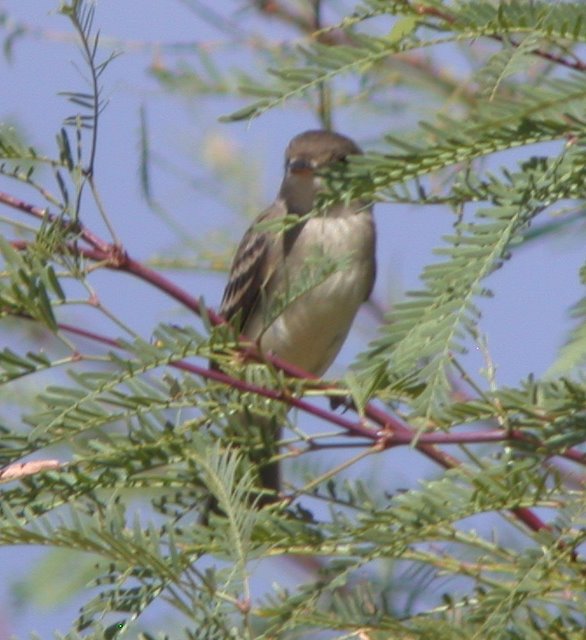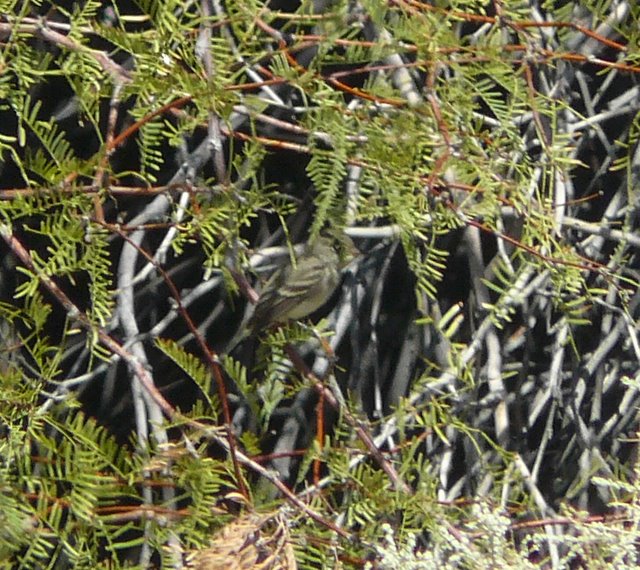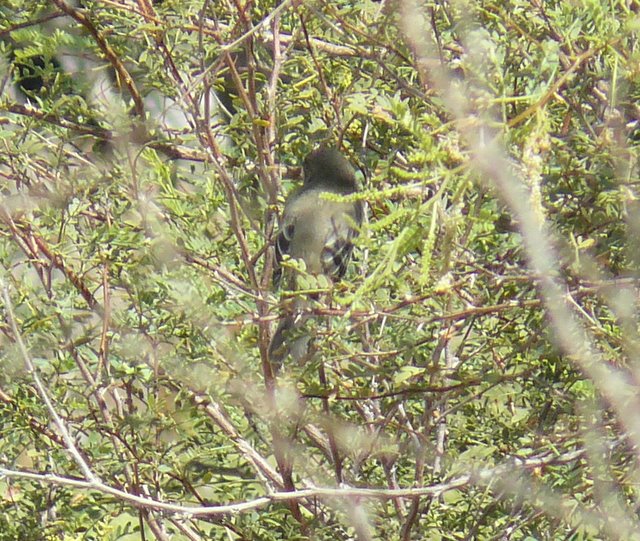Am Redstart, Palm Warbler, Swainson's Thrush, Least Fly at Death Valley
Observers: Chris and Rosie Howard, Barb Schuck
Email: chris93514@gmail.com
Date: 09/24/2007
Time: 12:15 PM -0400
 We spent 22-23 Sept birding Death Valley National Park.
The weather was great, a few clouds, highs in the 80s, not too windy. Birds were in fairly good numbers, especially warblers. Sparrows were present, but have not arrived in numbers yet (only a few Lincoln's and no Songs). Panamint Springs had a
Green-tailed Towhee. At Furnace Creek Ranch, we refound (presumably) the
American Redstart and Palm Warbler that Andy Zdon had on the 20th along Airport Road. We also enjoyed good views of a
Yellow-breasted Chat and distant views of a dull-plumaged Indigo Bunting (streaks on plain front, reduced wingbars). There was a
Swainson's Thrush (rare in fall, photo at right) in the Visitor Center quad. We had our first
Fox Sparrow, a small billed Slate-colored race, along Airport Rd. Empid numbers were low, but we did manage to identify 5 species over the weekend: 1
Gray at the Inn, 1 'Western' and a few Willow's scattered
about the Ranch, a
Hammond's at the Lida pond, and finally, a bird which we've identified as a
Least on the 23rd at Mesquite Springs.
We spent 22-23 Sept birding Death Valley National Park.
The weather was great, a few clouds, highs in the 80s, not too windy. Birds were in fairly good numbers, especially warblers. Sparrows were present, but have not arrived in numbers yet (only a few Lincoln's and no Songs). Panamint Springs had a
Green-tailed Towhee. At Furnace Creek Ranch, we refound (presumably) the
American Redstart and Palm Warbler that Andy Zdon had on the 20th along Airport Road. We also enjoyed good views of a
Yellow-breasted Chat and distant views of a dull-plumaged Indigo Bunting (streaks on plain front, reduced wingbars). There was a
Swainson's Thrush (rare in fall, photo at right) in the Visitor Center quad. We had our first
Fox Sparrow, a small billed Slate-colored race, along Airport Rd. Empid numbers were low, but we did manage to identify 5 species over the weekend: 1
Gray at the Inn, 1 'Western' and a few Willow's scattered
about the Ranch, a
Hammond's at the Lida pond, and finally, a bird which we've identified as a
Least on the 23rd at Mesquite Springs.
This would be our first Least in the West and we studied it for about an hour. This bird was very active, difficult to digiscope, and called regularly "whit", richer and sharper than the nearby Willow. It had a distinct, full eyering, reduced ever so slightly on the top, with no teardrop effect.
Unfortunately, the obvious eyering wasn't captured well in the photos, below. The bill was short, but wide-based, though not as short as the Hammond's we saw later. The lower mandible appeared entirely
yellow-orange colored below, but the photos show a darker distal tip. When viewed from above, the bill appeared narrow and dark, with noticeable white supraloral 'headlights'. The throat was cleanly white. The sides of the neck
were pale gray extending into the center of the breast. When it was
perched just above or on the ground, there was a hint of yellow on the belly. The wings were dark, but in bright sun, they were washed out and looked dark oliver brown with distinct light buffy bars. In bright shade, they appeared black (charcoal) with striking white edges to tertials. The wingbars also stood out, pale buff colored.
The mantle was not very colorful at all, mostly pale gray, but in bright shade, we could see some greenish color. The upper tail coverts and lower back were more olivey than the mantle. Very short primary projection, with noticeably rounded primary tips. The tail was not flicked much. From underneath, we could see R6 was about 1/2 cm shorter that the rest of the tailfeathers, and it also showed pale on the outer web.








 We spent 22-23 Sept birding Death Valley National Park.
The weather was great, a few clouds, highs in the 80s, not too windy. Birds were in fairly good numbers, especially warblers. Sparrows were present, but have not arrived in numbers yet (only a few Lincoln's and no Songs). Panamint Springs had a
Green-tailed Towhee. At Furnace Creek Ranch, we refound (presumably) the
American Redstart and Palm Warbler that Andy Zdon had on the 20th along Airport Road. We also enjoyed good views of a
Yellow-breasted Chat and distant views of a dull-plumaged Indigo Bunting (streaks on plain front, reduced wingbars). There was a
Swainson's Thrush (rare in fall, photo at right) in the Visitor Center quad. We had our first
Fox Sparrow, a small billed Slate-colored race, along Airport Rd. Empid numbers were low, but we did manage to identify 5 species over the weekend: 1
Gray at the Inn, 1 'Western' and a few Willow's scattered
about the Ranch, a
Hammond's at the Lida pond, and finally, a bird which we've identified as a
Least on the 23rd at Mesquite Springs.
We spent 22-23 Sept birding Death Valley National Park.
The weather was great, a few clouds, highs in the 80s, not too windy. Birds were in fairly good numbers, especially warblers. Sparrows were present, but have not arrived in numbers yet (only a few Lincoln's and no Songs). Panamint Springs had a
Green-tailed Towhee. At Furnace Creek Ranch, we refound (presumably) the
American Redstart and Palm Warbler that Andy Zdon had on the 20th along Airport Road. We also enjoyed good views of a
Yellow-breasted Chat and distant views of a dull-plumaged Indigo Bunting (streaks on plain front, reduced wingbars). There was a
Swainson's Thrush (rare in fall, photo at right) in the Visitor Center quad. We had our first
Fox Sparrow, a small billed Slate-colored race, along Airport Rd. Empid numbers were low, but we did manage to identify 5 species over the weekend: 1
Gray at the Inn, 1 'Western' and a few Willow's scattered
about the Ranch, a
Hammond's at the Lida pond, and finally, a bird which we've identified as a
Least on the 23rd at Mesquite Springs. 






